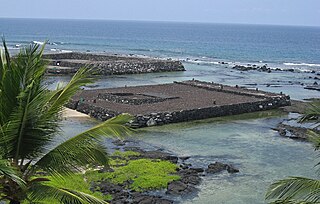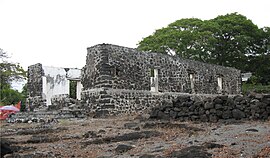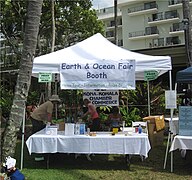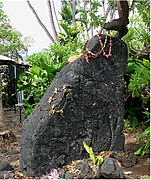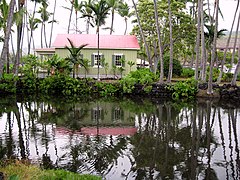
Kailua is an unincorporated city in Hawaiʻi County, Hawaii, United States, in the North Kona District of the Island of Hawaiʻi. The population was 11,975 at the 2010 census, up from 9,870 at the 2000 census. It is the center of commerce and of the tourist industry on West Hawaiʻi. Its post office is designated Kailua-Kona to differentiate it from Kailua located on the windward side of Oʻahu island, and it is sometimes referred to as Kona in everyday speech. The city is served by Kona International Airport, located just to the north in the adjacent Kalaoa CDP. Kailua-Kona was the closest major settlement to the epicenter of the 2006 Kiholo Bay earthquake.
The following is an alphabetical list of articles related to the U.S. state of Hawaii:

Sheraton Hotels and Resorts Hawaii is a Hawaiʻi subsidiary of Starwood Hotels & Resorts Worldwide under the Sheraton brand name. Based in Honolulu, the corporate group administers and manages the five Sheraton Hotels and Resorts on the islands of Kauaʻi, Oʻahu, Maui and the Big Island of Hawaiʻi. The hotels and resorts in Waikīkī are the Sheraton Princess Kaiulani Hotel and the Sheraton Waikiki Hotel. Sheraton Kona Resort and Spa at Keauhou Bay is in Kona on the Big Island while the Sheraton Maui is at Kaʻanapali Beach. The Sheraton Kauaʻi Resort was renovated after being destroyed by Hurricane Iniki on September 11, 1992.
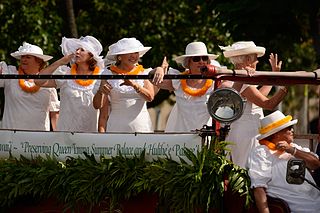
The Daughters of Hawaiʻi was founded in 1903 by seven women who were daughters of American Protestant missionaries. They were born in Hawaiʻi, were citizens of the Kingdom of Hawaiʻi before annexation, and foresaw the inevitable loss of much of the Hawaiian culture. They founded the organization "to perpetuate the memory and spirit of old Hawaiʻi and of historic facts, and to preserve the nomenclature and correct pronunciation of the Hawaiian language."' They run the Huliheʻe Palace and the Queen Emma Summer Palace.
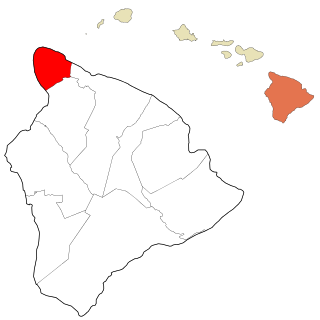
Kohala is the name of the northwest portion of the island of Hawaiʻi in the Hawaiian Archipelago. In ancient Hawaii it was often ruled by an independent High Chief called the Aliʻi Nui. In modern times it is divided into two districts of Hawaii County: North Kohala and South Kohala. Locals commonly use the name Kohala to refer to the census-designated places of Halaʻula, Hāwī, and Kapaʻau collectively. The dry western shore is commonly known as the Kohala Coast, which has golf courses and seaside resorts.

Kealakekua Bay is located on the Kona coast of the island of Hawaiʻi about 12 miles (19 km) south of Kailua-Kona. Settled over a thousand years ago, the surrounding area contains many archeological and historical sites such as religious temples (heiaus) and also includes the spot where the first documented European to reach the Hawaiian islands, Captain James Cook, was killed. It was listed in the National Register of Historic Places listings on the island of Hawaii in 1973 as the Kealakekua Bay Historical District. The bay is a marine life conservation district, a popular destination for kayaking, scuba diving, and snorkeling.

Kohala Historical Sites State Monument includes the National Historic Landmark Moʻokini Heiau and the birthplace of Kamehameha I. It is located in remote North Kohala on the Island of Hawaiʻi.

The ʻAkoni Pule Highway, Hawaiʻi State Highway Route 270, is the main road along the North Kohala Coast on the Island of Hawaiʻi from Kawaihae to ʻUpolu Point and then on to Pololū Valley Lookout. The entire route is 27.0 miles (43.5 km) long.
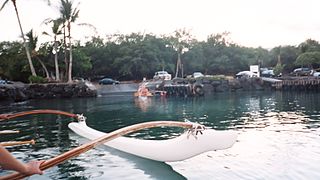
Kawaihae is an unincorporated community on the west side of the island of Hawaiʻi in the U.S. state of Hawaiʻi, 35 miles (56 km) north of Kailua-Kona.
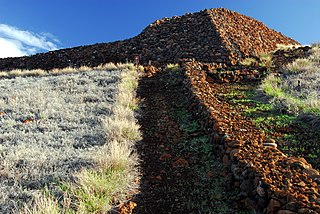
Puʻukoholā Heiau National Historic Site is a United States National Historic Site located on the northwestern coast of the island of Hawaiʻi. The site preserves the National Historic Landmark ruins of the last major Ancient Hawaiian temple, and other historic sites.

Kamakahonu, the residence of Kamehameha I, was located at the north end of Kailua Bay in Kailua-Kona on Hawaiʻi Island.

Kāneaka Hōlua Slide which is better known today as the Keauhou Hōlua Slide is located in Keauhou on the island of Hawaiʻi. It is the largest remaining hōlua course left in the islands, which needs to be better maintained and preserved as a usable hōlua course. This particular kahua hōlua was used in the extremely dangerous activity of sliding across solidified lava surface. Though many had believed for years that this ritualistic practice was restricted to the aliʻi class of men, this is not the case. The majority of oral and written histories of heʻehōlua prior to missionary/western influence was inclusive of the female as well as the male nobility of ancient Hawaii. Contrary to popular belief, heʻehōlua was widely practiced among all the Kanaka Maoli community throughout the paeʻāina (Kingdom). This particular hōlua course was primarily used for ritualistic purposes, but perhaps there were times when it was openly used. There are several burials found throughout the slide area suggesting that injuries and death were common when sliding down this particular course. The remaining length of the slide is approx. 2,600 feet (790 m) long, of the original length which was said to be over 5,280 feet (1,600 m) long. The slide course ended on the shoreline at Heʻeia Bay. Small portions of the hōlua course are still remain on the shoreline at the end of the hōlua slide where the waves meet the rock coastline. When constructed it was first layered with large slabs of pāhoehoe lava with smaller and smaller lava material added until the kahua hōlua was finished off with a fine ash surface to cover those larger pieces of lava rock. When in use, it was covered lightly with pili grass to provide a medium surface to minimize the friction between the papahōlua and lava rock surface during the practice of heʻehōlua. Today, there is one usable kahua hōlua slide that was constructed in 2011 and is located at Turtle Bay Resort, Kahuku, Oʻahu. Other than that heʻehōlua is practiced today in pastures on the high slopes of Hawaiʻi Island and Maui, as well as on groomed grass hills throughout Hawaiʻi.

Keauhou is an unincorporated community on the island of Hawaii in Hawaii County, Hawaii, United States. Its elevation is 13 feet (4 m). Because the community has borne multiple names, the Board on Geographic Names officially designated it "Keauhou" in 1914. Although it is unincorporated, it has a post office, with the ZIP code of 96739. The post office is a contract station only; people who live in the community use the zip code of 96740 or 96725.

Keauhou Bay is a historic area in the Kona District of the Big Island of Hawaiʻi. The name comes from ke au hou which means "the new era" in the Hawaiian Language.

The Kuamoʻo Burials is an historic Hawaiian burial site for warriors killed during a major battle in 1819. The site is located at Kuamoʻo Bay in the North Kona District, on the island of Hawaiʻi, United States.

Hōlualoa Bay is a historic area between Kailua-Kona and Keauhou Bay in the Kona District of the Big Island of Hawaiʻi. The community now called Hōlualoa is uphill from this bay. The name means "long slide" in the Hawaiian Language, from the long trail that went from a forest on the slopes of Hualālai, to a site where the logs were made into canoes into this bay where a large royal building complex was built over several centuries.

Waikoloa Beach is an area located on the South Kohala coast on the island of Hawaii and is located in the census-designated place of Puako. It can be confused for Waikoloa Village, a CDP in the same "ahupuaʻa" and is also known as "Waikoloa".

There are 75 golf courses in Hawaii.
Aliʻi Drive is the main street of Kailua-Kona, Island of Hawaii, United States.







